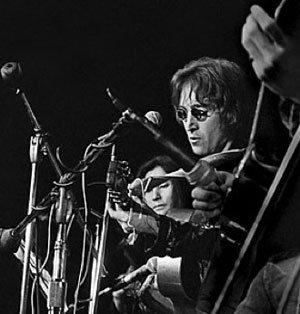The Ann Arbor Civic Band‘s Wednesday concert had a patriotic theme on a nearly perfect summer’s evening at the West Park band shell. [photo] [photo]
Stories indexed with the term ‘concerts’
Monthly Milestone: Watching Words
The Chronicle’s November milestone column comes to you a few days earlier than the customary second day of the month. That’s because I wanted to include a quick preview of a performance scheduled for Nov. 1 at the Kerrytown Concert House – by mezzo soprano Laurie Rubin.
The Chronicle has rarely, if ever, written about entertainment. And as I explained to Laurie, when she called me up to make her pitch, our approach to covering Ann Arbor’s community doesn’t include standard “preview” pieces for live performances.
The boilerplate explanation I typically use on the phone includes a description of The Chronicle’s preferred strategy for giving readers advance notice of interesting performances. That strategy is an event listing that runs off Internet standards-compliant data feeds and helps to strengthen the community’s “calendar web.” So obviously the tactic here is partly designed to bore the caller to death, so that they’ll just give up and accept the fact that I’m not going to write a preview article about their performance.
You will find Laurie’s Nov. 1 Kerrytown Concert House performance included in The Chronicle’s event calendar, categorized as music.
Fortunately for you, dear readers, Laurie declined my gambit that she surrender to my boring, rambling talk about data feeds and technology platforms. Instead she expressed a weirdly geeked-out interest in these data feeds and calendars, which I probably seemed very excited about. She instantly grasped the concept of maintaining a calendar that automatically generates a data feed that any publication or individual can access. I didn’t figure that an opera singer would be such a receptive audience for that sort of thing. But at least she had stopped talking about her Nov. 1 performance at Kerrytown Concert House, so that was a good thing, from my point of view.
But in closing out the conversation, Laurie renewed her pitch for a preview article, based on her memoir, “Do You Dream in Color: Insights from a Girl Without Sight.” Even though I was still thinking to myself, “No preview articles! Not even for blind opera singers!” I figured Laurie might be a receptive audience for some additional conversation about a different topic.
That topic is an accessibility project for public meetings that The Chronicle has been working on somewhat sporadically. The idea is to provide digital streaming text for members of the deaf and hearing-impaired community to read – either live at public meetings or during a video replay. Yes, I fully understood that I was talking to a self-described “blind girl” – for whom this particular accessibility project offered zero obvious benefit. Yet Laurie turned out to be a willing conversation partner. And in The Chronicle’s basic technological approach, she saw a potential benefit to the blind and visually impaired community that would never have occurred to me. [Full Story]
First & Washington
Line for the “top secret” invitation-only Darren Criss & Theo Katzman show Thursday night at the Blind Pig wraps around the corner of the Kiwanis building down Washington Street. Doors opened around 8:15 p.m. [photo]
Column: Gordon Lightfoot in Ann Arbor
This Wednesday Ann Arbor is in for a rare treat when Gordon Lightfoot – the fair-haired troubadour from north of the border whose repertoire includes such classics as “Early Mornin’ Rain,” “If You Could Read My Mind” and “The Wreck of the Edmund Fitzgerald” – makes his first local appearance in more than nine years, performing at the Michigan Theater.

Gordon Lightfoot in a recent publicity shot. He'll be performing at the Michigan Theater on Sept. 21, but has a decades-long history of touring here.
For his part, the 72-year-old singer-songwriter is glad to be returning. “I’m looking forward to it,” he says via telephone from his home in Toronto. “I’ve always gotten good vibes from Ann Arbor.”
Lightfoot first brought his guitar to town almost exactly 45 years ago, to play a three-night stint at a funky Episcopalian coffee house located in a former print shop at 330 Maynard Street. Today the unprepossessing brick building is home to Madras Masala, purveyor of exotic Indian delicacies; but in the ’60s it was Canterbury House, purveyor of coffee, donuts, and a hip spirituality that meshed nicely with the countercultural ethos of the day.
Canterbury House is actually a generic name used by many Episcopal student ministries at colleges across the nation. Ann Arbor’s incarnation was established in the mid-1940s and by the ’60s had become an important feature of the city’s increasingly progressive landscape. It began offering folk and blues music in 1965 as an experiment in reaching youth through the arts. Though mostly local performers were featured, the new program proved phenomenally successful, and the next year it was moved to a bigger location to bring in nationally-known acts.
First to appear at the extensively remodeled Maynard Street venue was the California-born “one-man folk festival,” Michael Cooney – “brandishing guitar, kazoo, banjo, autoharp, microphone, guitar strap, and truck,” according to the ad – who played three sold-out nights in early September.
Next up was a singer-songwriter from Ontario named Gordon Lightfoot, whose first album – the appropriately (if a bit over-exuberantly) titled “Lightfoot!” – had recently been released by United Artists. Although the young Canadian himself wasn’t that well-known in the states, his songs were. Marty Robbins took Lightfoot’s “Ribbon of Darkness” to the top of the country charts in 1965, and Peter, Paul and Mary made a Top 40 hit out of “For Lovin’ Me” that same year.
“If I had not gotten my songs recorded by some other artists very early on,” says Lightfoot, “I wouldn’t be talking to you right now. It was my songwriting, actually, that got me started.”
Which according to Herb David, proprietor of the famous guitar studio that bears his name, made Lightfoot very similar to another famous troubadour of that era, Bob Dylan. [Full Story]
The Day a Beatle Came to Town

John Lennon and Yoko Ono, playing at the 1971 John Sinclair Freedom Rally at Crisler Arena. (Photo courtesy Leni Sinclair.)
The passage of nearly four decades can dim even the keenest of memories. But to Hiawatha Bailey, the events of that winter afternoon in 1971 are as clear as if they had happened yesterday. Bailey was 23 and working at the communal headquarters of the Rainbow People’s Party in the ramshackle old mansion at 1520 Hill Street in Ann Arbor.
“I was doing office duty,” he recalls, “which entailed sitting at the front desk and answering the phone. Some friends were there, and we were sitting around, tripping on acid, probably, and the phone rings. I pick it up and I hear this voice, ‘Hello, this is Yoko Ono.’”
Bailey, of course, didn’t believe it for a second. “I said something like, ‘Yeah, this is Timothy Leary,’ and hung up. We all got a good laugh out of it.” A few minutes later the phone rang again. This time the voice on the other end said, “Hello, can I speak to David Sinclair, Chief of Staff of the Rainbow People’s Party. This is John Lennon of the Beatles.”
“I wasn’t even that familiar with the Beatles then,” says Bailey, now lead singer for the Cult Heroes, an Ann Arbor-based punk rock band. “I was more into the Stooges and the MC5, more radical rock ’n’ roll. But I knew right away that it really was John Lennon.” He put the call through.
“Dave and John talked for quite some time,” Bailey recalls. “Lennon said, ‘I heard about the benefit that you blokes are putting on, and I wrote a little ditty about John Sinclair and his plight. I’d like to come there and perform it.’” [Full Story]
Sonic Lunch Rocks Liberty Plaza

A group of girls dance to the music of Enter the Haggis at Thursday's Sonic Lunch, a free weekly concert series in Liberty Plaza.
Balloons, bubbles and the sound of bagpipes filled Liberty Plaza in downtown Ann Arbor last Thursday, as the Celtic rock band Enter the Haggis drew a crowd of people with soup and sandwiches in tow for the season’s first Sonic Lunch, a free, weekly outdoor concert series.
As the band warmed up – playing practice notes on their guitars and bagpipes – people filled the seats along the perimeter of the plaza, located at the corner of Liberty and Division. Some came wheeling their bikes, carrying helmets and water bottles. Many pushed strollers or strolled in holding the hands of small children (hands that soon grasped ribbons tied to blue and green balloons – signature colors of the Bank of Ann Arbor, the event’s main sponsor). When the built-in seats filled up, people rested in folding chairs or sat directly on the cement ground. [Full Story]




